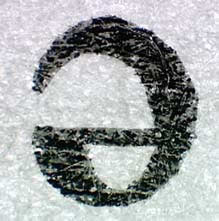Only prokaryotic cells can be unicellular (T/F)
F; Yeast!
Where should you place your hands when lifting and moving a microscope?
By the arm and the base
Compare and Contrast Differential media vs selective media
Differential media distinguishes for colonies based on a certain biochemical property while selective media only allows growth for colonies with desired properties. Concept here is that the former highlights what is wanted and the latter kills what is not wanted.
What is a positive control?
group in the study that always expectingly exhibits the wanted change
What is the most vitally important aspect of aseptic technique in any lab scenario?
Hand hygiene - Wash 15/20 seconds, scrub back of hand, palms and wrists before checking under fingernails. Rinse thoroughly and dry.
Please... just... wash... your... hands.
Ignaz Semmelweis will thank you from the grave.
What does it mean if a bacteria is pleomorphic
its structure is undefined or changes with age or in response to environmental stimuli.
What would the letter "E" look like under a microscope and what type of image is this
 virtual and inverted
virtual and inverted
Name four elements essential to bacterial growth
CHONSP
A study is done on the effects of proper sleep on cell mutation. What would be the null hypothesis?
Sleep patterns do not influence cell mutation
False. We only work with BSL 1 and 2.
BSL 3 requires sustained directional airflow that will not be recirculated.
What is the purpose of the heat smear?
To adhere the microbe to the glass slide and prevent dyes and liquids from washing it away; also to weaken cell walls and/or kill the organism.
What is the equation for magnification
power of objective lens multiplied by the power of the ocular lens
True/False: In many bacterial species, color defines age as this quality may change depending on the growth time and environment of the colony.
True. Some bacterial colonies will remain unpigmented until they begin to age or encounter various environmental conditions such as temperature or low nutrition availability.
Describe the major differences between the Gram positive and Gram negative cell wall.
Gram positive has a much thicker layer of peptidoglycan which floats on a thin, empty periplasm suspended above the plasma membrane. The outer portion contains teichoic acids for structure and signaling.
Gram negative cells have a much thinner peptidoglycan layer that floats within the periplasm sandwiched between the inner plasma membrane and outer membrane. The outer membrane includes a layer of lipopolysaccharide which contains lipid A, a known virulence factor.
What are the 4 colors of the biosafety hazard triangle and what do they represent

What is the purpose of Safranin in a gram stain
To help visualize gram negative bacteria by giving their previously colorless appearance a red/pink hue.
How much light waves refract is dependent on what quality of the medium?
Its density
Gram Positive cocci arranged in chains are known as?
Streptococci... so are Gram Negative cocci when arranged in chains.
BTW... you will not see Gram Negative cocci used in this course. They are often more virulent than other BSL 2 species.
What is the purpose of subculturing?
Transfer of cells from an existing pure culture to a fresh growth medium ensures longevity of the colony for continued use in practical lab applications.
How do we dispose of waste?
soak used live cultures in bleach for at least 20 minutes and preferably dispose of it in a designated trash can. ( protect your curious cat and dogs!)
throw sharp objects away in the designated sharp object container.( don't rip your trash bag, you'll have a bad time!)
NEVER pour live cultures down your sink.
Give 3 of the 5 flagellar arrangements and define

What is the purpose of immersion oil?
Immersion oil reduces refraction of light lending to impeccable image clarity and resolution.
Pink bacterial rods with a more oval shape are known as... ?
Gram Negative coccobacilli
How is a pure culture obtained
streak isolation using nutrient agar plates
When performing a streak isolation, the petri plate lid is carefully lifted slightly just enough to allow movement of the loop to brush the agar surface. What is the name of this technique and why is it necessary?
Clamshell technique. It is necessary to prevent contamination by free living microbes that might drop into the plate.